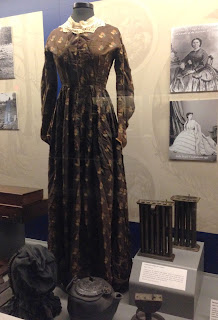222 Worth
Road
St. Louis, MO 63125
Admission
is $7 for individuals, $6 for seniors, and $5 for veterans and students. Parking is free.
Website: http://mcwm.org/
This
relatively new museum opened in June 2013, funded mostly by individual
donations. The museum and gift shop are housed in the 110-year-old brick
building built in 1905 as the Post Exchange & Gymnasium Building for
Jefferson Barracks. Over the years the building also served as a barrack, an
overflow hospital, and again as an entertainment center for soldiers. After sitting empty for sixty years, the
not-for-profit Missouri Civil War Museum organization was formed and spent ten
years restoring the building and raising funds for the museum.
A
visit to the museum begins with a 5-minute background film then on to the two
galleries on the main floor. The first
room, the Pre-War Gallery, has displays and a video covering four major events that led to
the Civil War.
The second large room, the Col. John Emerson Main Gallery, has
numerous displays about the war in Missouri.
The displays cover a variety of topics.
 |
| The three-inch ordinance rifle cannon in the center of the gallery. |
On
the lower level there are several rooms including Jefferson Barracks: Through the Years.
Another new exhibit on the lower level is Hollywood and the Civil War.
 |
| Saddle used in mini series North and South |
There
are also Post War Exhibits.
Finally
in the lower level is a theater with a large screen showing a film about Civil
War museums, battlefields, and other various Civil-War related sites in the state
of Missouri.
The
number of uniforms throughout the museum displays is very impressive. There is clothing for most every area
including these below.
 |
| Knights Templar Uniform |
 |
| Two examples of women's dresses |
The highlight of this museum are the over 800
artifacts. All are displayed well and
are accompanied by excellent written descriptions
 |
| Gunpowder Loading Flasks and Shot Bags |
 |
| Surgical/Amputation Set made in Paris |
 |
| Zither and Rosewood Fife |
 |
| Pocket Surgical and Dissection Sets |
 |
| Sabers and other weapons |
 |
| Carpenters Tools |
 |
| Artillery Artifacts |
One
of the most interesting artifacts is a 19th century undertaker’s
cooling table. The sign tells us this: During
the Civil War, the need to transport fallen soldiers back home for burial is
what led to the dramatic rise and acceptance in America of preserving human
remains. Cooling tables were used by
local undertakers and taken to the “parlor” room of a residence to display the
deceased prior to burial. Cooling tables
have many holes drilled in them to allow cool air to flow upon the body from a
block of ice that was placed under the table.
It is
amazing the number of Civil War books available to purchase at the museum.
In addition to used books there is a nice sized gift shop with not only
books and DVD’s but also Civil War memorabilia and Jefferson Barracks
souvenirs.
A number of the old barracks are visible from
the museum steps.
Next
to the museum is a smaller brick building that the museum has purchased and is
restoring to use as a center for Civil War research and study.
Nearby the museum we had lunch at a wonderful relatively-new restaurant
called Café Telegraph. http://cafetelegraph.com/
The
café’s co-owner, “Stan the Man”, spent quite a bit of time talking with us. He fortunately convinced us to try their smoked wings which may just be the best
wings any of us have ever eaten. The café is known for its smoked meats as well
as its pork chops and sweet potato fries, etc. All excellent. We will
definitely return.
A
group of uniformed servicemen came to the cafe for lunch while we were there and between
a member of our our party and another table, their complete tab was picked
up. We learned that being close to
Jefferson Barracks, the café has soldiers most days and 50% of the time other
costumers pay for their meals.
Comments:
We spent about 90 minutes at the museum, going through the exhibits at our own
pace. One could obviously spend more
time there if they read every display. There are no guided nor audio tours.
With five films and hundreds of artifacts this is obviously a very visual museum. There are no interactive displays. The displays are laid out easy to read and
the artifacts are well-described. The main floor displays are easy to follow
and again very visual. The downstairs’
displays are in multiple little rooms. The films are well-made. The films are on their own schedule so
sometimes we entered rooms while a film was in progress and it was hard to know
when the film would begin again.
This
is also a museum in progress as they are
continuing to add and complete displays.
As a
not-for-profit institution, several ways to donate are made available. They are especially seeking donations to
complete the building next door.
We
have learned that there are bus tours that visit the museum. Fortunately this afternoon we were alone in all of the
exhibits but I would recommend calling ahead before visiting to check on
the likelihood of tour groups being there. Their website shares this: Due to the high volume of praise and positive reviews through
TripAdvisor, the museum is listed in the Top 3 Museums of St. Louis and
received a 2013 Certificate of Excellence.
Nearby Jefferson Barracks Park and Jefferson Barracks National Cemetery include additional museums and monuments of historical interest. The cemetery has a number of notable interments among the 188,000 buried there.
Final recommendation: Go to Café Telegraph for lunch or dinner!


































































